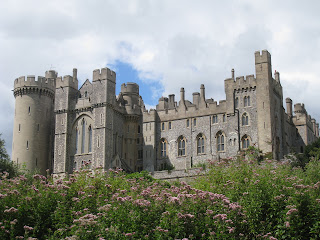ARUNDEL FOR KIDS
Special posting by Tiki Stew: DJ, father and all around good bloke
 |
| Tiki Stew in the middle with his son |
NOT TO MISS for KIDS
- The room with all the swords--the Armory room.
- In the dungeon there was a dummy that my kids liked because my son said he had no clothes on and green feet. I said the moss had made his feet go green.
- In the chapel there was a monk, and I took his habit off and he had the proper monk haircut. And there was a dummy behind him who had no face.
 |
| Picnic on the castle grounds |
The castle had the best toilets ever, with hot and cold running water. The thing I liked about it, was the toilets, the cafe, the gift shop was all still in the castle. And the kids loved the chocolate cake.
ARUNDEL CASTLE
Special posting by SARA KERRY
 |
| The view of the northeast from the Keep |
ARUNDEL CASTLE Special posting by Marshall Dow Hahn-Taylor, rock solid spouse |
 |
| Descending the stairs in the Keep |
 |
| The original Keep, built in 1067 by Earl Roger |
THE HISTORY BEHIND ARUNDEL CASTLE
Special posting by Laura Jane Waters,
authentic British lady and history geek
The castle was founded in 1067 by Roger de Montgomery, one of William the Conqueror's most loyal supporters. He had been rewarded for his support during the successful Norman invasion of 1066 with lands covering a third of the county of Sussex and the Earldom of Arundel, with the stipulation that he built a castle close to the mouth of the River Arun to protect the coast from attack. The original castle was a motte and bailey (mound and courtyard) with a wooden keep (tower) built high up on the motte.
Earl Roger's son Robert inherited the castle and Earldom and fought against the next king, Henry I. The king retook Arundel Castle and banished the Earl to Normandy. When Henry I died, his wife remarried and the castle passed into the Albini family. They rebuilt the Keep in stone in 1138. On her death Henry II inherited the estate and built the main castle. Arundel remained in the Albini family until the 13th century when it passed through marriage to the Fitzalan family. In the 16th century Henry Fitzalan, 12th Earl of Arundel, was the last of his line and when his daughter married Thomas Howard, 4th Duke of Norfolk, Arundel Castle passed to the Howard family where it has since remained.
The Fitzalan Chapel and Barbican (gatehouse) can be found in the castle grounds - they were built in the 1380s. During the English Civil War (1640s) cannons were placed on the roof of the chapel by the parliamentarian forces (supporters of the government against the Royalists, who were loyal to the King). The barbican was damaged by cannon balls. The castle was eventually taken and parts of it were blown up when the troops left in 1653. Massive restoration was undertaken in the 19th century.
DON'T MISS
- The Armoury - including a rare 15th century jousting saddle and the 14th century Mongley sword that formerly belonged to the Castle Warden.
- An amazing collection of paintings by artists including Canaletto, Gainsborough and Van Dyck plus family portraits - look out for the 3rd and 4th Earl of Norfolk who plotted and schemed their way through Tudor and Elizabethan England.
- The magnificent Victorian Gothic interiors, considered to be some of the finest in England. The house was almost completely rebuilt between the 1870s and 1890s. Queen Victoria and Prince Albert visited Arundel and you can see furniture made specially for them in the Queen Victoria's Bedroom. In 2009 Arundel was used as a location for the film YOUNG VICTORIA.
- The spectacular Collector Earl's Garden, a formal garden opened in 2008 and inspired by Jacobean garden design, particularly those which may have existed at Arundel House in London in the early 1600s.
 |
| Outside of Fitzalen Chapel, where the ancestors are interred |
 |
| Castle gardens with the cathedral in the background |
 |
| Arundel Castle |
 |
| At the playground just down the street from Arundel Castle |
View Larger Map
Consider the following points of interest for Hill Babies in the area:
- Arundel Castle website
- hiking Devil's Dyke (about 5 miles)
- hiking the Seven Sisters (up to 12 miles)
- walking from Brighton to Hove Lagoon (2.5 miles each way)
- playing at Stoneham Recreation Ground in Hove
- exploring Brighton Pier
- exploring the battlefield where Normans fought Anglo-Saxons in 1066
 |
| Hard to leave the castle |













